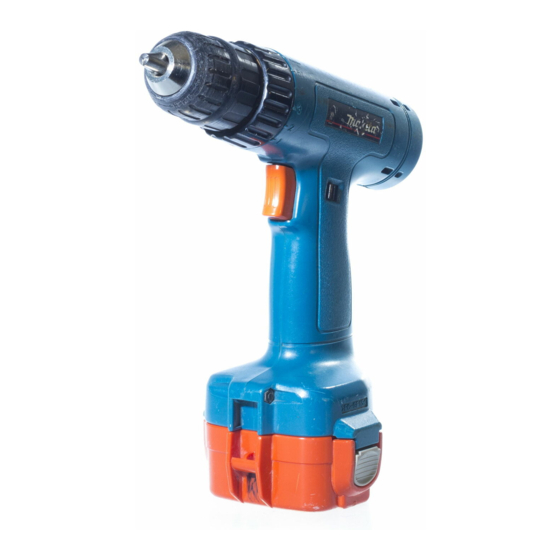Makita 6223D Instruction Manual - Page 4
Browse online or download pdf Instruction Manual for Drill Makita 6223D. Makita 6223D 11 pages. Cordless driver drill
Also for Makita 6223D: Instruction Manual (12 pages)

Installing or removing driver bit or drill bit (Fig. 2)
Important:
Always be sure that the tool is switched off and the battery
cartridge is removed before installing or removing the bit.
Hold the ring and turn the sleeve counterclockwise to
open the chuck jaws. Place the bit in the chuck as far as
it will go. Hold the ring firmly and turn the sleeve clock-
wise to tighten the chuck. To remove the bit, hold the ring
and turn the sleeve counterclockwise.
Switch action (Fig. 3)
CAUTION:
Before inserting the battery cartridge into the tool, always
check to see that the switch trigger actuates properly and
returns to the "OFF" position when released.
To start the tool, simply pull the trigger. Tool speed is
increased by increasing pressure on the trigger. Release
the trigger to stop.
Reversing switch action (Fig. 4)
CAUTION:
• Always check the direction of rotation before operation.
• Use the reversing switch only after the tool comes to a
complete stop. Changing the direction of rotation
before the tool stops may damage the tool.
This tool has a reversing switch to change the direction of
rotation. Slide the reversing switch to the left for clock-
wise rotation or to the right for counterclockwise rotation.
Adjusting fastening torque (Fig. 5)
The fastening torque can be adjusted in six stages by
turning the adjusting ring so that the pointer on the
adjusting ring points to a number on the tool body. The
fastening torque is minimum when the pointer points to
the number 1 and maximum when it points to the
u
marking. The clutch will slip at varying torque
levels when the pointer is set at the numbers 1 to 5. The
clutch is designed not to slip at the
Before actual operation, drive a trial screw into your
material or a piece of duplicate material to determine
which torque level is required for a particular application.
NOTE:
The adjusting ring cannot be locked with the pointer posi-
tioned half-way between the numbers.
Installing set plate (Fig. 6)
Always install the set plate when using battery cartridges
9100, 9102 or 9102A. Install the set plate on the tool with
the screw provided as shown in Fig. 6.
4
u
marking.
Screwdriving operation (Fig. 7)
Place the point of the driver bit in the screw head and
apply pressure to the tool. Start the tool slowly and then
increase the speed gradually. Release the trigger as
soon as the clutch cuts in.
NOTE:
• Make sure that the driver bit is inserted straight in the
screw head, or the screw and/or bit may be damaged.
• When driving wood screws, predrill pilot holes to make
driving easier and to prevent splitting of the workpiece.
See the chart.
Nominal diameter
of wood screw (mm)
3.1
3.5
3.8
4.5
4.8
5.1
Drilling operation
First, turn the adjusting ring so that the pointer on the
adjusting ring points to the
ceed as follows.
• Drilling in wood
When drilling in wood, best results are obtained with
wood drills equipped with a guide screw. The guide
screw makes drilling easier by pulling the bit into the
workpiece.
• Drilling in metal
To prevent the bit from slipping when starting a hole,
make an indentation with a centre-punch and hammer
at the point to be drilled. Place the point of the bit in the
indentation and start drilling.
Use a cutting lubricant when drilling metals. The excep-
tions are iron and brass which should be drilled dry.
CAUTION:
• Pressing excessively on the tool will not speed up the
drilling. In fact, this excessive pressure will only serve
to damage the tip of your bit, decrease the tool per-
formance and shorten the service life of the tool.
• There is a tremendous force exerted on the tool/bit at the
time of hole breakthrough. Hold the tool firmly and exert
care when the bit begins to break through the workpiece.
• A stuck bit can be removed simply by setting the reversing
switch to reverse rotation in order to back out. However,
the tool may back out abruptly if you do not hold it firmly.
• Always secure small workpieces in a vice or similar
hold-down device.
MAINTENANCE
CAUTION:
Always be sure that the tool is switched off and the bat-
tery cartridge is removed before carrying out any work on
the tool.
To maintain product safety and reliability, repairs, mainte-
nance or adjustment should be carried out by a Makita
Authorized Service Centre.
Recommended size
of pilot hole (mm)
2.0 – 2.2
2.2 – 2.5
2.5 – 2.8
2.9 – 3.2
3.1 – 3.4
3.3 – 3.6
u
marking. Then pro-
